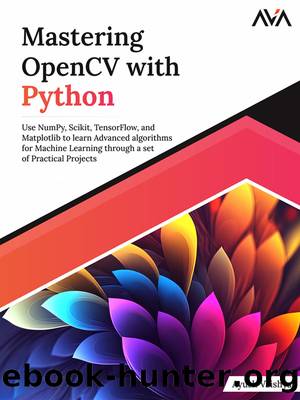Mastering OpenCV with Python: Use NumPy, Scikit, TensorFlow, and Matplotlib to learn Advanced algorithms for Machine Learning through a set of Practical Projects by Ayush Vaishya

Author:Ayush Vaishya [Vaishya, Ayush]
Language: eng
Format: epub
ISBN: 9789390475797
Publisher: Orange Education Pvt Ltd, AVA™
Published: 2023-11-15T00:00:00+00:00
Solidity
Solidity is a measure of how closely a shape matches its convex hull, which is the smallest possible convex shape that completely encloses the object. In layman terms, Solidity refers to how solid or filled a shape appears.
If the solidity value is closer to 1, it means that the shape is mostly filled and doesnât have many holes or concave parts. On the other hand, if the solidity value is closer to 0, it means that the shape has many holes or concave regions, making it less solid.
Solidity is calculated by dividing the contour area by the area of its convex hull representing the proportion of the area covered by the convex hull:
Solidity = (Contour Area) / (Convex Hull Area)
Solidity can be useful in various applications. For example, in object recognition, it can help distinguish between solid objects and objects with holes or concavities or can also be used to filter out irregular shapes or noise in image segmentation tasks.
Download
This site does not store any files on its server. We only index and link to content provided by other sites. Please contact the content providers to delete copyright contents if any and email us, we'll remove relevant links or contents immediately.
Algorithms of the Intelligent Web by Haralambos Marmanis;Dmitry Babenko(16237)
Jquery UI in Action : Master the concepts Of Jquery UI: A Step By Step Approach by ANMOL GOYAL(9389)
Test-Driven Development with Java by Alan Mellor(7737)
Data Augmentation with Python by Duc Haba(7610)
Principles of Data Fabric by Sonia Mezzetta(7380)
Learn Blender Simulations the Right Way by Stephen Pearson(7296)
Microservices with Spring Boot 3 and Spring Cloud by Magnus Larsson(7139)
Hadoop in Practice by Alex Holmes(6589)
RPA Solution Architect's Handbook by Sachin Sahgal(6519)
The Infinite Retina by Robert Scoble Irena Cronin(6218)
Big Data Analysis with Python by Ivan Marin(5937)
Life 3.0: Being Human in the Age of Artificial Intelligence by Tegmark Max(5519)
Pretrain Vision and Large Language Models in Python by Emily Webber(4897)
Infrastructure as Code for Beginners by Russ McKendrick(4654)
Functional Programming in JavaScript by Mantyla Dan(4438)
WordPress Plugin Development Cookbook by Yannick Lefebvre(4386)
The Age of Surveillance Capitalism by Shoshana Zuboff(4252)
Embracing Microservices Design by Ovais Mehboob Ahmed Khan Nabil Siddiqui and Timothy Oleson(4149)
Applied Machine Learning for Healthcare and Life Sciences Using AWS by Ujjwal Ratan(4136)
